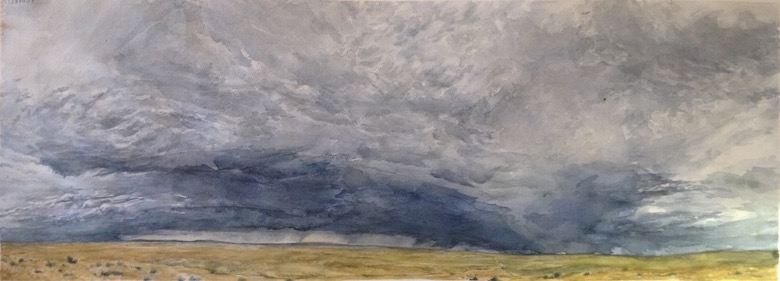 There’s a particular shade of blue that I’ve tried to replicate with pigment for much of my life. I think it’s blue, anyway. There’s gray in there, too. Indigo. Violet. Black. Flickers of gold. This blue is luminous, despite its darkness. This blue is heavy and satisfying as a thirst, slaked.
There’s a particular shade of blue that I’ve tried to replicate with pigment for much of my life. I think it’s blue, anyway. There’s gray in there, too. Indigo. Violet. Black. Flickers of gold. This blue is luminous, despite its darkness. This blue is heavy and satisfying as a thirst, slaked.
I can’t point to any objects that are this color. It belongs to something more ephemeral: The bruised underside of a storm when the sun is at a 4-o’clock slant on the opposite horizon, burning the prairie grass white in the space between. It’s a waiting color, one that heralds a sky shattered with lightning, boom-cracking thunder that ricochets inside your ribcage, and the transformation of hardpan to ankle-grabbing mud. The things that come when the spreading anvil cloud drags the hard shield of its belly over your head—tightening the blue now to opaque gray, then obliterating it in sheets of rain.
On roadtrips with my family to the High Plains when I was a teenager, I’d turn in a circle to click photos of that storm-and-sun dance with a little 35-millimeter film camera. Later, copying the artist David Hockney, I’d tape the images together into panoramic composites, and sit down in high school art class with an oblong sheet of thick paper to try to paint that sky, that blue, with my watercolors. The results were forever disappointing.
When the pigment was wet, when it had a little meniscus of water that could catch and bend the light, it verged on rightness. But once dry, it looked flat and depthless, no matter what colors I added to the blues smeared across my plastic palette and washed over my paper. Where the cloud-belly blue was many things, my approximation was always just one thing. The difference between them was the difference between a living flicker of songbird and a dead one stuffed and laid out in a specimen drawer.
Oil paint came closer, with its permanent transparency and thickness, its ability to hold and keep light, as if it had never dried. In its creamier brushstrokes, the white dust of some Wyoming road flared bright against a larkspur-deep hue of cumulus. Like a real scene you could step into. But it still felt truncated, as if you’d walked onto the plains only to discover you were in an artfully constructed museum diorama, where you could lay your hands on the distant mountains, but you’d never be able to walk there.
The trouble, I’d guess, was not with the accuracy of my attempts to copy the hue. Nor even with the media I chose in my efforts to replicate it. The paintings themselves are competent, even lovely. The trouble was that my thirsty blue was something more dynamic than the narrow category of color could hold, built of a group of associations beyond sight, not just made of light, but of smells—sun-hot van upholstery and gasoline, smashed sage and floury dust—and of space—rolling hills and flats unbroken by house or powerline. Fencelines like half erased pencil strokes on their way to vanishing completely. There was a gale in it, and a stillness, and a certain shimmer of tall, dry grass. My attempts to contain it inevitably made it into something else.
I still paint, but I’ve started searching for the blue elsewhere instead. I’ve spotted it in deep, hanging-valley tarns, in ocean swells, in late day forest shadows and pockets of puddle-reflected sky, in more storms over more places than I can count. I am gathering a remembered library of its incarnations. If I want to invoke any of them, though, the only answer is this: Go out into the world. Walk. Watch. Lived experience is its own sort of art.
The watercolor, “Storm Over Froze To Death,” ca. 1999, is original artwork by the author.
Very nice, Sarah. Beautiful imagery.
Beautiful!!!!
Your writing is always honest.
Burnt umber and ultra marine.
Working in the realm of “Senses & Making Sense in Nature” (in the context of conditional impairments – of the nervous system and the like) love, love, love the spatial semantic synesthesia in this sentiment: “my thirsty blue was something more dynamic than the narrow category of color could hold, built of a group of associations beyond sight, not just made of light, but of smells—sun-hot van upholstery and gasoline, smashed sage and floury dust—and of space—rolling hills and flats unbroken by house or powerline. ” The physical literacy Sarah conveys is also quite compelling. Thanks so much for sharing from your library of incarnations!